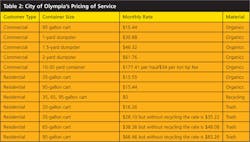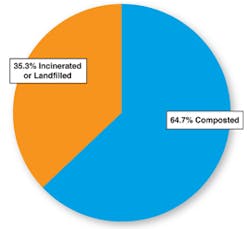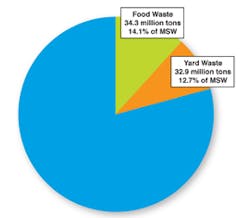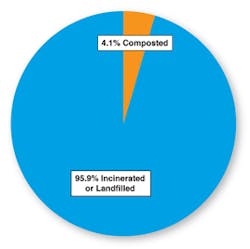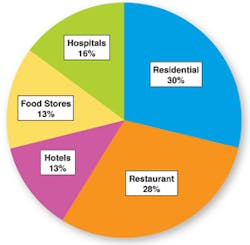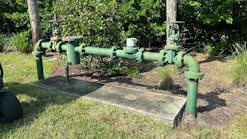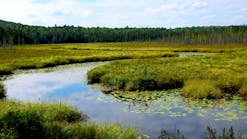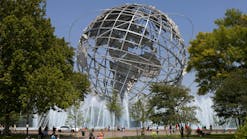We currently use over a third more resources a year than our planet can sustain. This now has affected not only our ecological environment, but also the platform where our economy stands. “Sustainability” appears to be a term that is merging environmental science with economic principles. John Skinner, the executive director of the Solid Waste Association of North America, gave a paper to the International Solid Waste Association World Congress in Daegu, Korea, on October 17, 2011, where he said the definition of “sustainable solid waste management … refers to an environmentally and economically sustainable approach to the management of MSW.”
In the October 20 edition of The Collegian, a university newspaper, Kenta Murakami writes: “Environmentalism isn’t just about saving rainforests or whales; it’s an issue tied directly into job creation, energy sustainability, a healthier world, a less-cruel world, and the preservation of the human race.”
“Environmentalism,” says attorney Mike Nasi of the Biodiesel Coalition of Texas, “is ideologically based to the point where it becomes easy to see the world through an us-versus-them language, which ultimately breaks down our ability to make rational decisions about how we manage our finite resources.”
According to the United Nations Population Fund, we reached 7 billion people worldwide as of October 31, 2011. Women in India lead the race by currently giving birth to 51 babies per minute. Conservative population estimates for 2050 project 9 billion! In his book, The Great Disruption, Paul Gilding combines the effect of population growth with economic projections produced by the International Monetary Fund and believes that the economy in 2050 will be 3.5 times larger than it was in 2005. With the logic of compound interest and the understanding that we humans are already using more natural resources per year than the earth can sustain, Gilding writes “…if we start at 140% of [the planet’s] capacity in 2009, then 22 years takes us to 280% of capacity in 2031 and 44 years takes us to 560% in 2053.” By midcentury, in other words, he and others project that we will annually consume the resources of five earths.
Some analysts believe they now see before us the proverbial fork in the road. Going right at the fork continues us on the traditional path of priming the economic pump to generate new jobs and conserve resources whether it is through the tactics of restrained or unleashed government spending. People like Gilding, however, are choosing to veer left where they see an economy that sustains itself on the resources the earth annually provides. Whichever path our governments decide to take, one thing is for sure: Solid waste managers will be asked to work harder toward sustainable resource management. This article is an attempt to review the issue of organics through sustainable management.
National Organic Landscape
According to the USEPA there is a lot of foodwaste yet to collect. Figure 1 shows the EPA’s estimates on generation per weight of foodwaste and yardwaste for 2009.
Yardwaste increasingly has been diverted from landfills over the past three decades. More counties and some states actually ban the burning of yardwaste, and 24 states ban or restrict yardwaste from landfill disposal. Yardwaste accounts for one-fourth of US recycling rate and 21.3 million tons are composted annually at 3,500 permitted yardwaste composting facilities. Figure 2 shows the percent of yardwaste composted versus landfilled/incineration.
An estimated 34.29 million tons of foodwaste is generated annually, and only 1.4 million tons, or 4.10%, is recovered and composted, as shown in Figure 3. Some commercial or institutional kitchens dispose of foodwaste through commercial in-sink disposal units on the way to wastewater treatment centers, where they become biosolids products, such as compost. Figure 4 shows that approximately 28% of foodwaste is generated by restaurants similar to the 30% from residences. Collecting from commercial and institutional establishments has a far greater economy of scale than collecting from residences, however, simply because the collection truck gets equal or more tons in significantly fewer collection stops. Approximately 100 cities and counties are on the frontier of collecting foodwaste for composting facilities. For diversion purposes, it is the biggest portion of the wastestream left to capture and process.
USEPA Region 5 recently funded a national survey carried out by the Econservation Institute, entitled, Best Management Practices in Food Scraps Programs. This survey found that there are 183 food collection programs, the vast majority implemented since 2004. Residential food scrap collection accounted for 88% of these programs, commercial made up 37%, and commercial-only food scrap programs made up 11%. In 70% of these residential programs, there was but one single contracted hauler providing the service; for the commercial programs, that number dropped to 50%. The report breaks down where these programs are, as shown in Table 1.
The survey also examined the economic context of the programs and found that for 88% of these communities with programs, tip fees for organic material were less than landfill tip fees, while for the remaining 12% of the programs the opposite was true. The average landfill tip fee, the report says, was $82 per ton, while the average organic tip fee was $44.
Not unexpectedly, variable rate or pay-as-you-throw incentives were in 79% of these programs. The average household rate per month for trash collection was $21.79 and for organics it was $7.68. In collection programs where yardwaste and food scraps were combined, the average setout in pounds per participating household was between 33 to 37 pounds per week, with a diversion rate of 52%.
Communities Seeking Effective Organic Management
The city of Moncton is within the County of Westmorland in the Province of New Brunswick, Canada. Since 1999, Moncton households and multidwellings, up to five units, set out for collection two nondegradable colored bags. The green bag is for wet items. If something is “sticky, gooey, yucky, mucky, or dirty” then it goes into the green bag. This includes yardwaste and foodwaste including meat products as well as soiled or contaminated paper. Households also set out a blue bag of dry waste for collection. These bags contain everything else including recyclables.
Six city-owned-and-operated Canadian-made Labrie trucks roll out of the Moncton public yard at midnight to collect these bags. These trucks are outfitted with two compactor units using a 60/40 split where the dry waste is placed in the 60% compactor and the wet waste in the other. “The ratio works,” says works supervisor Mayhew Lloy. He points out that each one-man crew collects approximately 766 homes a night by itself, lifting and tossing both the dry and the heavy wet bags into the truck’s hoppers. Together, the wet and dry material weigh 11 tons per route, adding up to 55 tons of lifting each week, or 2,860 tons each year per employee. There are no carts. There are no automated arms reducing the workload for these human catapult machines. This is the cold nighttime work of a Moncton solid waste employee.
Cities like Moncton take their collected material to the Westmorland-Albert Solid Waste Corp. (WASWC), which was formed in 1992 out of a public strategy to close 200 dumps and replace them with environmentally friendly solid waste management facilities united by a public customer base utilizing the benefits of economies of scale. The dry waste is deposited at a materials recovery facility (MRF) where it is separated into categories after going through four sorting stations. Thirty-five people work each of two shifts to process the material. Currently, the sales receipts per ton of recyclables range from $70 to $620 (HDPT #2). Currently, it is the only Canadian jurisdiction collecting polystyrene, which is sold at $100 per ton.
Figure 4: Source of foodwaste
The wet waste is loaded onto a tip floor, then into a hopper, where it goes through a bag opener before being deposited into a trammel screen full of knives to chop up the waste. The screen has 70-mm holes; anything larger is rejected from the process, and anything smaller drops through the holes and goes under two magnets to remove the ferrous metals and then through a grinder. Such bulking agents as wood shavings are applied, and the material is directed to one of eight silos for composting. These silos are computerized, controlled environments having 32 zones to add water and 42 zones to add air to the compost to control the temperature.
The technology for composting the wet stream is TDR, out of Spain. The compost facility has a total of three full-time employees to work this automated system. These silos are flat channels 270 feet long, 9 feet wide, and 6 feet high. The silos have rails on top with turners attached, turning the compost and moving it forward 9 feet a day. The compost spends 28 days in the channels before going through a refining process to remove contaminates, and then outside for curing. The material is used onsite as well as sold as a Class A compost to landscapers and residents.
The WASWC projects that the system has extended the life of the landfill from 100 to 140 years. The cost per ton is $13. The WASWC charges its customers $51 per household per year total for the processing of dry as well as wet material.
“We do all the work,” says Bill Slater the general manager of the commission. “For example, we just recently added polystyrene to the recycling program, but we didn’t have to educate the homeowners, because they were already putting it into the dry bag. We simply had to educate our workers in the MRF. There is not a simpler system out there.”
In 1998 the city council of Olympia, WA, successfully voted to implement alternate every-other-week pickup for garbage and recycling. Mark Foutch, who was on Olympia’s council and who voted for this collection change, says there were many public hearings to discuss the pros and cons of this new collection system. Although people were worried about decomposition and smells, Foutch remembers that it was the “progression of increasing consumer confidence” toward public works staff on one hand and “understanding better what we were doing at each step” on the other that created citizen support.
By utilizing the same equipment and staff, collection costs of multiple items were shared among a smaller amount of equipment and employees. In 2003, Olympia went to fully automated collection and began single-stream recycling. In 2008, Olympia offered every-other-week collection of foodwaste: meat, bones, fish, dairy, and other organics such as yardwaste, thereby providing collections for single-stream recycling, organic waste, and trash to 13,500 single family dwellings. This three-cart system had financial incentives built into it with a pay-as-you-throw model as well as the incentive of every-other-week collection. For commercial customers, the city’s solid waste division provides free waste assessments and two months of free organic collection if the business signs up for 12 months of service. Public works will also train the customer’s staff, and the city will soon be offering a window on its website advertising that the business is participating in organics recovery. Table 2 reviews Olympia’s fees for service.
Islands have a way of reminding people of the finite nature of land. In Hawaii, beginning in the early 1990s, Maui County’s recycling coordinator, Hana Steel, melded together an interesting and unique program whereby the county’s biosolids were co-composted with greenwaste to produce a marketable compost product. The county delivers approximately 25,000 tons of biosolids and other wastewater products to the contractor’s facility located on approximately 10 acres at the Central Maui Landfill (CML). Citizens and commercial entities also bring approximately 30,000 tons per year of greenwaste to the contractor’s facility. The greenwaste and pallets are unloaded by the customer, and Maui EKO Systems, the contractor, processes them through a tub grinder to produce a nominal minus-4-inch wood chip. The biosolids are dumped into a specially designed receiving pit by the delivery vehicles and mixed with the wood chips. The wood chips (bulking agent) are added in a four-to-one bulking-agent-to-biosolids ratio by volume. Atop a complex of aeration tubes, the mixture of biosolids and bulking agent is formed into a pile 12 feet high. Air is suctioned through the pile by 24 fans providing oxygen to aid the biosolids to degrade into Phase I compost in about 60 days. At this point, the material is moved to Phase II for curing for 90 to 120 days, after which it is screened for size and quality control and then sold.
Fats, oils, and grease (FOG) are diverted and processed into biofuel. FOG presents complications when added to the co-composting process because those components are harder to digest. The contractor solved this problem by processing FOG separately and subcontracting with Pacific Biodiesel Inc. (PBI) to divert the FOG at its biofuel processing plant on the site provided to Maui EKO Systems by the county. In FY 2008, the PBI Maui facility accepted approximately 5,000 tons of FOG and converted it into 250,000 gallons of biodiesel and an unspecified quantity of crude biofuel, which powered its own machinery. Pacific Biodiesel markets the biodiesel in pure form and blended with convention diesel.
Robert King, founder and chief executive officer of Pacific Biodiesel, changed over to biodiesel from his previous business, King Diesel. Pacific Biodiesel is now 16 years old and has 36 employees in the state of Hawaii and over 60 employees in its Northwest operations. The company has built 12 biodiesel processing plants, with the 13th currently being built on the Big Island. Plants are located in the states of Hawaii, Virginia, Maryland, Pennsylvania, Texas, Nevada, California, Oregon, and Alaska, with an additional plant in Nagano, Japan. The Hawaiian processing plants produce around 800,000 gallons a year, and the facility in Salem, OR, produces 5 million gallons annually. Pacific Biodiesel has worked as a business model, Vice President Kelly King says, because it is “community-sized, robust and sustainable.”
King and her company have been recognized with awards, including the Green Jobs Award in November 2011 in New York City. In 2005, PBI was awarded the BlueSky Award as one of the Top Ten Global Renewable Energy Investment Scenarios by the United Nations Industrial Development Organization and the International Technology Promotion Center, and in 2004 it won the Gold Award from the Solid Waste Association of North America. Although these awards come from a lot of hard work, King also has a bit of good luck that became very public when she recently took part in the Sustainable Biodiesel Alliance All Star Texas Hold ‘Em Charity Tournament, sponsored by Willie Nelson and Woody Harrelson. A self-professed novice poker player, King found herself the winner of the tournament after almost eight hours of play, cleaning the wallets of the other 59 players.
Even with this recognition and success, King sees government not clearly understanding sustainability. “There is no consistency,” she says, “with both federal and state programs that encourage people to invest their money into long-term capitalization of bioenergy. At times a gallon of biodiesel may be less than petrol diesel and sometimes more, illustrating that, unlike petrol, biodiesel can be stable in pricing. Government policymakers don’t grasp that $0.90 of every dollar purchased at a biodiesel pump stays in the state while only $0.10 of every petrol dollar remains here.” Biodiesel firms have the ability to benefit the local economy in ways that companies like Exxon do not. “Financially, the Maui Solid Waste Division sees a net gain, as approximately $2.4 million revenue is received by the division from tip fee for the wastestreams, and approximately $1.8 million is spent on the contract to process the material.”
“Maui County,” says Steel, “is now planning for the implementation of residential foodwaste from its customers and having this resource co-composted as well.” Foodwaste will be placed into the organics cart along with yardwaste and taken to the facility to be co-composted. “We are building upon the organics system we started in 1996, thereby gaining the benefits of economy of scale, something that is rather difficult to do on an island, and allowing our step toward curbside residential food scrap collection to be economically feasible,” says Steel.
The method of processing organics is at least as old as Pliny the Elder, who wrote that as early as Homer we find compost being used to fertilize fields. With our era’s urbanization, however, the nutrients we have grown and sent to the cities for people to consume are no longer coming back to the soils in any great amount. Take the following quote from the forward in a book:
“Nature treats the earth unkindly. Man treats her harshly. He overplows the cropland, overgrazes the pastureland, and overcuts the timberland. He destroys millions of acres completely. He pours fertility year after year into the cities, which in turn pour what they do not use down the sewers into the rivers and the ocean.”
In the same forward the author writes: “The public is waking up, and just in time. In another 30 years it might have been too late.” The author of this forward was Henry Wallace, secretary of agriculture for President Franklin Roosevelt, and the book is the United States Department of Agriculture’s Soils and Men: Yearbook of Agriculture, 1936.
“That book,” says Bob Shaffer, “said we were depleting our soil of carbon.” The health of the soil to agronomists, such as Shaffer, is ill. The clarion warning call was in 1936 but, he says, the green revolution of synthetic fertilizers took us off course. “The green revolution failed horribly. It was a nightmare of agriculture,” he says. Compost made from recycled food scraps is slowly being embraced by farmers as a way to improve soil health and become soil sustainable. “We need to return minerals and carbon to the soil. Anytime that we sequester carbon to the soil, not only does it help the life of the soil to produce higher quality crops, but it creates better soil health and sequesters carbon that should not be in the air causing pollution and ozone problems. The revolution started in the kitchen, and it’s moving out to the field right now. It is recycled, food-based compost that is important.”
Shaffer splits his time between farming his own coffee beans on the Island of Hawaii and working on the mainland as a composting consultant to farmers and Recology, a company that collects and composts San Francisco’s foodwaste. Working for farmers across the country, Shaffer points out that the soil gets depleted by the decades of production of food goods and the lack of carbon-rich inputs like compost and cover crops. He sees that food compost along with the use of cover crops, such as grasses, legumes, and forbs, and proper tilling techniques create a synergy that sequesters more carbon than compost or cover crops by themselves. The world, he says, only has 10% of land that is suitable to raise crops. Food-based compost has a higher quality of nutrients and minerals in it than other applications, such as manure, where the animal has already extracted a large amount of the calcium, phosphorous, sulfur, and potassium. But, he says, “foodwaste that hasn’t been digested, such as lettuce, carrots, or beans, has all of those nutrients in it.” If we don’t compost, it then it would go to the landfills and be “minerals lost forever, producing methane, which is a problem for us.”
Sustainable farming requires these nutrients to go back into the soil, but is this economically feasible given the production cost of food-based compost? “I don’t know of one compost producer in northern California,” he says, “who doesn’t sell out his entire compost inventory before the end of the summer.” Over the last decade, Shaffer points out, materials such as sulfur, phosphate, and nitrogen have doubled in price because they are linked to gas prices, both in mining of minerals and extraction of minerals from petroleum chemical sources. “Whereas,” he says, “there are 68 billion pounds of foodwaste going into the landfills annually that have the very nutrients, and carbon, we need. We are buying fertilizers that are not renewable and don’t work any better than compost. Educating the public and the farmer is key to changing this dynamic.”
New Business Model For Trash
Formerly Norcal Waste Systems, Recology is an employee-owned trash-hauling business based in San Francisco. “Sixty percent of the waste material we touch in San Francisco is diverted away from the landfill,” says Mike Sangiacomo, president and chief executive officer of Recology. He believes that revenue from the sales of the recyclables and the compost approximately matches the cost of what the company landfills.
Greg Pryor manages Recology’s Jepson Prairie Organics and says that as of November 2011, the Jepson facility has processed 1,100,000 tons of compost since it opened in 1996. Currently, 400 tons of organics enter the site each day, with 165 of those tons being food scraps. Pryor started composting with the Ag-Bag system, whereby a compost recipe is stuffed into thick and long plastic bags, sealed at the ends, and blowers hooked up throughout the length of the tube to force in air.
In 2006, Pryor moved to a windrow system with a felt canopy, scaled back the size of the equipment, and reduced the size of the piles. California regulators wanted to thoroughly check the VOC emissions of this new system and so had Recology build a 1,000-cubic-yard test pile over 60 days. On the 59th day, the regulators began to investigate, from the beginning of the pile to its end, and found the VOCs far below state minimums. This reinforced to composters that if the carbon to nitrogen ratio is right, the moisture is correct, the turning regime is consistent, and with proper particle size of the feedstock, then the microbes that produce the VOCs will be managed and not generate them at high levels.
In 2009, Pryor implemented ECS’s aerated static pile system with a negative-airflow biofilter compost system in order to reduce the compost-processing footprint from 16 to 6 acres. Essentially, this is a covered composting system with steel tubing drawing air to a biofilter of wood chips. The chips are chosen for their size and type of wood and are kept moist to trap VOCs in the gas coming out of the compost. The wood chips are changed out every two to three years, after they lose their porosity and carbon content, and placed into a compost pile for composting.
At the heart of Recology’s Jepson business are “boutique composts.” Schaffer has done thousands of soil analyses in the local market and develops specific recipes for specific farmers. “For many farmers,” Schaffer says, “it is cost prohibitive to purchase the small amounts of minerals needed.” Jepson will take rock phosphate and calcium carbonate and add these minerals to the compost pile at its beginning. When humic acids come into contact with phosphate, they form a more available version of the phosphate, making it more beneficial to the soil. Recology also develops compost teas with its special blend extracted from compost piles begun 15 years earlier. These teas then are inoculated into new compost piles, introducing different types of fungi and other organisms. This boutique compost is sold to biodynamic farmers and, Schaffer says, is considered “100% organic by the National Organic Program. By combining all of the needed minerals into one batch of compost, Schaffer says, the farmer eliminates the need for multiple passes of the field, thereby saving time and expense.
Sangiacomo underscores the fact that Recology invested this kind of effort and resources in composting because of the policy decisions of the city and county of San Francisco. “Communities that think of sustainability issues when they are deciding upon programs,” he says, “are willing to be the lab where the private sector can do things that were initially somewhat experimental. If the governments weren’t willing to support that effort, we would not have gotten to where we are.”
Anaerobic Digest Jitterbug
Other countries have danced with anaerobic digestion (AD) of organics. Tel Aviv, Israel, has been using ArroBio’s anaerobic digester since 2003 and is processing 320 tons per day, producing biogas and compost. Malchin, Germany, has an Entec facility that processes 55,000 tons of foodwaste a year, creating 2 MW of electricity from biogas and compost. Over 65,000 tons of source-separated organics go into a Harvest Bioenergy facility in London, Ontario, producing 22,000 kWh of energy and 4,000 tons of compost.
Two years ago, the city of San Jose, CA, embarked on a procurement to simplify commercial waste collection and divert as much away from the landfill as possible. In May 2011, the San Jose city council authorized staff to enter into negotiations for a 15-year contract with Zero Waste Energy Development Co. (ZWED) to process organics using the European-patented Kompoferm Plus dry anaerobic digestion system. Multiple companies had submitted proposals to the city with ZWED proposing both the AD and a conventional composting process. City staff recommended to the mayor and council ZWED’s AD system. According to its “Report on RFP for Commercial Solid Waste System,” the following reasons were given by staff:
- The AD system moves the city toward sustainability by being able to “capture methane gas from organic waste and convert it to gas, which can be converted into electric power or vehicle fuel.”
- AD is progressive and “more innovative technology that will serve as a model for green technology.”
- AD can reduce odors and greenhouse gas reductions.
ZWED submitted a cost per ton for both its AD and traditional compost processes. The AD was $66.38 a ton and the traditional compost proposed fee was $66.86. The winning proposal will mean an annual cost to the city of approximately $4.4 million. However, the city expects to pay this fee directly from the collection franchise revenue, approximately $11 million.
The new system will have the hauler collect commercial waste in one container, deliver it to a facility where the organics are separated from recyclables and trash, and sent to ZWED. GreenWaste Recovery Inc. and Zanker Road Resources Management Ltd. own ZWED, which employs the design firm JR Miller & Assoc. to assist with this project. In October 2011, the contract was finalized, and the ZWED facility will be operating in early 2013. Currently, there are seven such commercial facilities operating in Europe, ranging in annual throughput between 14,000 and 90,000 tons, with the oldest opening in 2007.
Eggersmann Anlagenbau, the developer and owner of the patented KompofermPlus technology, is a German independent enterprise under the umbrella organization of Eggersmann Group, which began in 1951 as a construction and architectural firm for agricultural and commercial projects. In the 1980s the firm advanced into new environmental technologies. In 2006, it developed a new procedure of dry fermentation for the production of biogas called Kompoferm. The ZWED facility will be self-generating electricity and recovering heat in a 1,600 MW CHP system that will provide a projected 1,300 kW for sale to Pacific Gas & Electric.
Once the facility is built, the city of San Jose’s mixed commercial organic waste, 70 to 90,000 tons of organics annually, will be delivered daily to the 95,000-square-foot plant built on city-owned land. The material will be prescreened to remove nonorganic residue and then placed into a dry anaerobic digestion system that eliminates the need for significant waste preparation and water addition as is commonly required in wet anaerobic digestion systems. The digesters are biologically self-heated through an in-floor air system and liquid that has percolated through the material is recirculated back into the material in a closed-loop system. This percolate liquid contains thermophilic biological constituents to negate the use of previously digested material needed to start subsequent batches. The material is in the dry fermentation digester for 21 days, followed by five days of in-vessel composting and then up to 60 days in windrow form to cure.
Jeff Bogg, the project delivery manager for ZWED’s AD facility, believes that this thermophilic process improves the quality and quantity of biogas production for uses in such renewable energy applications as renewable electricity and compressed natural gas. The facility is expected to produce 1.6 MW of electricity and between 30,000 to 35,000 tons of compost annually.
“This new organics process is just one of a three-prong strategy to fulfill our goal of being a sustainable city,” says Jeff Janssen, senior policy advisor to San Jose Mayor Chuck Reed. The mayor’s office is close to submitting two contracts to San Jose’s council, to handle other problem wastestreams.
The first is biosolids and woodwaste streams that the city currently transport three hours away for disposal. The city has entered into negotiations with Harvest Energy, which has a gasification technology that combines the biosolids with the woodwaste under high temperatures converting them into a clean natural gas that the city can use in its own operations. The remaining ash material will be sold as a bonding agent for cement companies.
The second wastestream is that of FOG. A company, FOG Environmental, currently has one digester that is equipped to handle FOG, producing a clean fuel. The city, says Janssen, has examined two years worth of performance data from the private company and is preparing to go to council for approval to retrofit three of San Jose’s 15 digesters with FOG Environmental’s system, creating a clean gas at the Water Pollution Control Plant.
“The Mayor’s office” says Janssen, “spends considerable time developing strategies that advance the private sector’s ability to handle problem wastes while also mitigating the city’s risks.”
Making the Decision
Sustainable organic management is not just about diversion. It is about finding a strategy that diverts material in a cost- and energy-efficient manner that adds value to other operations and provides benefit to our ecological system in such ways as better soils, better nutrition, creating clean energy, reducing harmful emissions, and conserving resources. It seems certain that environmental, regulatory, and financial pressures will press US cities to embark on a rethinking of their collection/processing/disposal systems where alternatives such as wet/dry, alternating collection schedules, high-quality composting, and anaerobic digestion among others are analyzed using a sustainable management model.
Website Resources
Ag-Bag System
www.ag-bagfs.com/compost.html
Anaerobic-Digestion Website
www.anaerobic-digestion.com
Biodiesel
www.biodiesel.org
California AB 32 to reduce global warming
www.arb.ca.gov/cc/ab32/ab32.htm
City of Moncton
www.moncton.ca/Residents/Garbage_and_Recycling.htm
City of Olympia
www.olympiawa.gov/city-utilities/garbage-and-recycling.aspx
County of Maui Solid Waste Division
www.co.maui.hi.us/index
Econservation Institute
www.foodscrapsrecovery.org
Eggersmannn Group
www.f-e.de/partner-en.html
Engineered Compost Systems
www.compostsystems.com
Entec Biogas
www.entec.com
Gershman, Brickner & Bratton Inc.
www.gbbinc.com/index.shtml
GreenWaste Recovery Inc.
www.greenwaste.com
Harvest Power
www.entec.com
JR Miller & Associates
www.jrma.com
National Organic Program Rules
www.ams.usda.gov/AMSv1.0/nop
Pacific Biodiesel
www.biodiesel.com
Recology
www.recology.com
Rodale Institute
www.rodaleinstitute.org
Silver Springs Organics LLC
www.silverspringsorganics.com
USEPA
www.epa.gov/osw/conserve/materials/organics/food/
World Watch Institute
www.worldwatch.org/node/501
Wright Environmental Management Inc.
www.wrightenvironmental.com
Zanker Road Resources Management Ltd.
www.zankerrecycling.com
